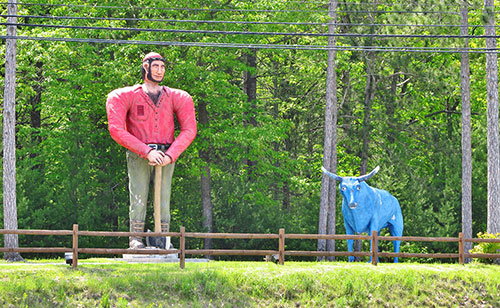Paul Bunyan and His Michigan Roots
Paul Bunyan is probably the best known hero in American Folklore. Tall tales about the exploits of this larger-than-life lumberjack and his faithful sidekick, Babe, the Big Blue Ox, are over one hundred years old. While the exact origin of Bunyan isn’t known, he certainly has at least one of his over-sized work boots firmly planted in Michigan, where he’s still celebrated today.

The Paul Bunyan statue in Ossineke Michigan. Photo credit Jasperdo.
One scholarly theory says Paul Bunyan is an exaggerated characterization of a real man named Fabian Fournier. Fournier was a French-Canadian who moved to Michigan to work as a lumberjack in the booming logging industry after the Civil War.
Fournier was something of a legend himself. He was known to be an outstanding lumberjack. He was also large in stature, said to have two sets of teeth, tough and willing to pick a fight and likely win. He was known by the nickname Saginaw Joe. Unfortunately, his reputation got the best of him, and he died in a bar fight in Bay City in 1875.
Around the same time, there were also stories circulating about another French-Canadian whose name was Bon Jean. He was a soldier and war hero. It’s possible that over time Fournier’s and Bon Jean’s stories merged into one tall tale with Paul Bunyan as the leading man. Paul Bunyan being the botched American pronunciation of Bon Jean.
Others believe Bunyan’s origins are in the late-night talks of loggers in Wisconsin and Michigan. Stories ware made up and told around the campfire, then traveled orally as loggers moved from camp to camp.
In 1906, the Oscoda Press in Michigan published an article telling a series of Bunyan stories. It was the first time such stories appeared in print. The article was written by James MacGillivray, a lumberjack and Oscoda local. Four years later when the Detroit News reprinted MacGillivray’s stories, Bunyan reached a wider, mainstream audience. The stories, which included Babe the Big Blue Ox and other extraordinary exaggerations, became the basis for the legend we know today.
The State of Michigan recognizes Oscoda as the birthplace of Paul Bunyan. Oscoda is situated on the shores of Lake Huron in the northern half of Michigan’s Lower Peninsula. The small town hosts the annual Paul Bunyan Days festival every September. The event includes a carnival, craft show, pie eating contest and lots of folks sporting red flannel and hiking boots. You’ll also find a large statue of Paul Bunyan located in a park in Oscoda.
Just 40 minutes north of Oscoda in Ossineke, you’ll find another likeness of Bunyan. This time he’s accompanied by Babe. And in St. Ignace, in the Upper Peninsula, just across the Mackinac Bridge, Paul and Babe make another appearance. You’ll find them at the base of Castle Rock. The natural rock formation is a tourist attraction and scenic overlook that provides an expansive view of the Straits of Mackinac and Mackinac Island. Continue West on U.S. 2 from St. Ignace, and you’ll come to Manistique on the northern shores of Lake Michigan. You’ll find yet another statue of Paul Bunyan.
In real life, Paul Bunyan and Babe contribute much to Michigan’s rich history, and even to its economy, drawing in tourists each year. In legend, their greatest contribution defines Michigan’s landscape and is the very heart of the state.
Bunyan and Babe worked hard logging trees all over Michigan and Wisconsin. After all that exertion, Bunyan noticed they were both a little dirty and smelly. They needed a bath. But there was no bathtub large enough for a 40 foot tall man and an ox just as big. Bunyan decided to dig some enormous holes and fill them with water, so they could bathe. Those holes became the Great Lakes.
Other states besides Michigan claim Bunyan as their own, including Maine, Wisconsin and even California. As it turns out, this giant of an American legend is big enough for all of us.



